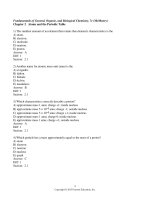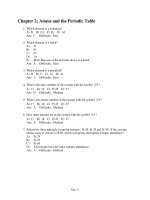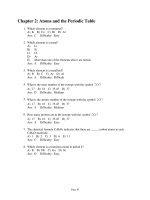General organic and biological chemistry structures of life CH 19 1 proteins amino acids GOB structures 5th ed
Bạn đang xem bản rút gọn của tài liệu. Xem và tải ngay bản đầy đủ của tài liệu tại đây (1.35 MB, 21 trang )
Lecture Presentation
Chapter 19
Amino Acids and Proteins
Karen C. Timberlake
General, Organic, and Biological Chemistry: Structures of Life, 5/e
Karen C. Timberlake
© 2016 Pearson Education, Inc.
Chapter 19 Amino Acids and Proteins
•
Radiology technicians work with radiologists to
produce images that allow for the diagnosis
and treatment of certain medical conditions.
•
Technicians operate imaging equipment such
as X-ray, computed tomography (CT), and
positron emission tomography (PET).
General, Organic, and Biological Chemistry: Structures of Life, 5/e
Karen C. Timberlake
© 2016 Pearson Education, Inc.
Chapter 19 Readiness
Key Math Skill
•
+
Calculating pH from [H3O ] (11.6)
Core Chemistry Skills
•
•
•
Writing Equations for Reactions of Acids and Bases (11.7)
Naming Carboxylic Acids (16.1)
Forming Amides (18.5)
General, Organic, and Biological Chemistry: Structures of Life, 5/e
Karen C. Timberlake
© 2016 Pearson Education, Inc.
19.1 Proteins and Amino Acids
Protein molecules, compared with many
of the compounds we have studied, can
be gigantic.
The horns of animals are made of
proteins.
Learning Goal Classify proteins by their functions. Give the name and abbreviations for an amino
acid, and draw its zwitterion.
General, Organic, and Biological Chemistry: Structures of Life, 5/e
Karen C. Timberlake
© 2016 Pearson Education, Inc.
Functions of Proteins
Proteins
•
•
in the body are polymers made from 20 different amino acids.
differ in characteristics and functions that depend on the order of amino acids that make up
the protein.
•
•
form structural components such as cartilage, muscles, hair, and nails.
function as enzymes to regulate biological reactions such as digestion and cellular
metabolism.
•
including hemoglobin and myoglobin transport oxygen in the blood.
General, Organic, and Biological Chemistry: Structures of Life, 5/e
Karen C. Timberlake
© 2016 Pearson Education, Inc.
Structural Classification of Proteins and Functions
General, Organic, and Biological Chemistry: Structures of Life, 5/e
Karen C. Timberlake
© 2016 Pearson Education, Inc.
Amino Acids
Amino acids, the molecular building blocks of proteins, have a central carbon atom called the α carbon,
bonded to
•
+
−
two functional groups: an ammonium group (— NH 3 ) and a carboxylate group (— COO )
•
a hydrogen atom and an R group or side chain in addition to the carboxylate and ammonium groups.
General, Organic, and Biological Chemistry: Structures of Life, 5/e
Karen C. Timberlake
© 2016 Pearson Education, Inc.
Zwitterions
At physiological pH, the
•
ionized ammonium and carboxylate groups give
an amino acid a balance of positive and negative
charge, which gives an overall zero charge.
•
neutral amino acid, which is called a zwitterion,
occurs at a specific pH value known as its
isoelectric point (pI).
Core Chemistry Skill Drawing the Zwitterion for an Amino Acid
General, Organic, and Biological Chemistry: Structures of Life, 5/e
Karen C. Timberlake
© 2016 Pearson Education, Inc.
Classification of Amino Acids
Amino acids are classified using their specific R groups. The
•
•
•
nonpolar (hydrophobic) amino acids have hydrogen, alkyl, or aromatic R groups.
polar amino acids have R groups that interact with water, which makes them hydrophilic.
polar neutral amino acids contain an hydroxyl
(— OH), a thiol (— SH), or an amide (— CONH 2) R group
•
polar acidic amino acids contain a carboxylate
−
(— COO ) R group.
•
polar basic amino acids contain an ammonium
+
(— NH3 ) R group.
General, Organic, and Biological Chemistry: Structures of Life, 5/e
Karen C. Timberlake
© 2016 Pearson Education, Inc.
Classification of Amino Acids
A summary of amino acid types and their interactions with water
General, Organic, and Biological Chemistry: Structures of Life, 5/e
Karen C. Timberlake
© 2016 Pearson Education, Inc.
Nonpolar Amino Acids
An amino acid is nonpolar when the R group is H, alkyl, or aromatic.
General, Organic, and Biological Chemistry: Structures of Life, 5/e
Karen C. Timberlake
© 2016 Pearson Education, Inc.
Polar Amino Acids, Neutral R Groups
An amino acid is polar when the R group is an alcohol, a thiol, or an amide.
General, Organic, and Biological Chemistry: Structures of Life, 5/e
Karen C. Timberlake
© 2016 Pearson Education, Inc.
Amino Acids, Charged R Groups
−
An amino acid is charged when the R group is a carboxylate (— COO ) or an ammonium (—
+
NH3 ) group.
General, Organic, and Biological Chemistry: Structures of Life, 5/e
Karen C. Timberlake
© 2016 Pearson Education, Inc.
Study Check
Draw the zwitterions for the amino acids serine and aspartate.
General, Organic, and Biological Chemistry: Structures of Life, 5/e
Karen C. Timberlake
© 2016 Pearson Education, Inc.
Solution
Draw the zwitterions for the amino acids serine and aspartate.
ANALYZE
Given
Need
THE
serine
draw the zwitterions
PROBLEM
aspartate
Serine
General, Organic, and Biological Chemistry: Structures of Life, 5/e
Karen C. Timberlake
Aspartate
© 2016 Pearson Education, Inc.
Amino Acid Abbreviations
Amino acids have
•
•
three-letter abbreviations derived from their names, given in Table 19.2.
one-letter abbreviations to allow the faster transfer of data.
Of the 20 amino acids,
•
11 have one-letter abbreviations that are the same as the first letter in their names and 9 use different
letters.
•
arginine R and tyrosine Y use the second letters in their names; phenylalanine is F; and lysine is K,
which is near L in the alphabet.
General, Organic, and Biological Chemistry: Structures of Life, 5/e
Karen C. Timberlake
© 2016 Pearson Education, Inc.
Amino Acid Stereoisomers
Amino acids can exist as D and L stereoisomers called enantiomers. We draw Fischer projections for αamino acids by placing
•
•
the carboxylate group at the top.
the R group at the bottom.
•
+
the — NH3 group of the L isomer on the left.
•
+
the — NH3 group of the D isomer on the right.
General, Organic, and Biological Chemistry: Structures of Life, 5/e
Karen C. Timberlake
© 2016 Pearson Education, Inc.
Study Check
Identify the following amino acids as
A.
D
or L enantiomers:
B. –
COO
+
H3N––C––H
CH2
H
COO –
+
C ––NH3
CH2
OH
General, Organic, and Biological Chemistry: Structures of Life, 5/e
Karen C. Timberlake
© 2016 Pearson Education, Inc.
Solution
Identify the following amino acids as
A.
D
or L enantiomers:
B. –
COO
+
H3N––C––H
H
COO –
+
C ––NH3
CH2
CH2
OH
L-Phenylalanine
General, Organic, and Biological Chemistry: Structures of Life, 5/e
Karen C. Timberlake
D-Serine
© 2016 Pearson Education, Inc.
Chemistry Link to Health:
Essential Amino Acids
Of the 20 amino acids used to build the proteins in the body,
•
•
only 11 can be synthesized in the body;
the other 9 are essential amino acids that must be obtained from the proteins in the diet.
General, Organic, and Biological Chemistry: Structures of Life, 5/e
Karen C. Timberlake
© 2016 Pearson Education, Inc.
Chemistry Link to Health:
Essential Amino Acids
Complete proteins such as eggs, milk, meat,
and fish contain all of the essential amino
acids.
Incomplete proteins from plants such as grains,
beans, and nuts are deficient in one or more
essential amino acids.
General, Organic, and Biological Chemistry: Structures of Life, 5/e
Karen C. Timberlake
© 2016 Pearson Education, Inc.









